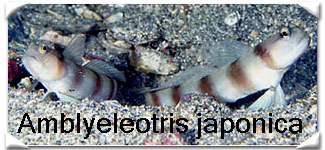






As shrimp and goby spend most of their lives inside their burrows, any observations made on the reproductive strategy of these individuals is extremely difficult. In fact, nearly nothing was known about these species until Yanagisawa (1982, 1984), studied Amblyeleotris japonica in great detail in Japan. Most of my synthisis of goby repoduction comes from that work. Below is a table of the known breeding periods of different shrimp gobies.
| FISH | Time of Pairing | Location | Reference |
| Vanderhorstia delogoae | April - Nov | Red Sea | Karplus pers obs |
| Amblyeleotris seinitzi | April - Nov | Red Sea | Karplus pers obs |
| Ctenogobiops maculosus | April - Dec | Red Sea | Karplus pers obs |
| Eilatia latrucularia | April - Dec | Red Sea | Karplus pers obs |
| Vanderhorstia mertensi | May-Sept | Japan | Yanagisawa 1982 |
| Amblyeleotris japonica | May - Sept | Japan | Yanagisawa 1982 |
| Toiyamichthys oni | All Year | Japan | Yanagisawa 1982 |
| Psilogobius mainlandi | All Year | Hawaii | Preston 1978 |
| Cryptocentrus fasciatus | All Year | GBR, AUS | Cummins 1979 |
| Cryptocentrus cinctus | All Year | GBR, AUS | Cummins 1979 |
| Amblyeleotris steinitzi | All Year | GBR, AUS | Cummins 1979 |
| Ctenogobiops pomastictus | All Year | GBR, AUS | Cummins 1979 |
From this table, it is clear that there is no concrete pattern that can be observed for goby mating amoung all species. Even for one species, Amblyeleotris steinitzi, found in Australia and the Red Sea, the pattern is not consistent. It does seem however, that when gobies are not found paired all year, they are found paired predominantly in the summer months.
 Pairing
for Amblyeleotris japonica, occurs from May to September in Japan
at which time there were maximaly only about 7 percent of associations
paired (Yanagisawa 1982). Males were the individuals that would roam around
within the breeding territory but rarely more than a few meters away from
their burrows. Territorial displays are made between males for the right
to mate and most matings occured from the largest, most socially dominant
individual. There was no sign, however, of males mating with several females.
Instead, they would pair with a female and remain with them for several
days. When the female laid the eggs (approximately 20,000), she would
leave and the male would take care of the eggs, mostly inside the burrow
for the next 4-7 days until hatching.
Pairing
for Amblyeleotris japonica, occurs from May to September in Japan
at which time there were maximaly only about 7 percent of associations
paired (Yanagisawa 1982). Males were the individuals that would roam around
within the breeding territory but rarely more than a few meters away from
their burrows. Territorial displays are made between males for the right
to mate and most matings occured from the largest, most socially dominant
individual. There was no sign, however, of males mating with several females.
Instead, they would pair with a female and remain with them for several
days. When the female laid the eggs (approximately 20,000), she would
leave and the male would take care of the eggs, mostly inside the burrow
for the next 4-7 days until hatching.
SHRIMP
Yanagisawa has also spent considerable time discovering the reproduction of the Alpheid shrimp in southern Japan (Yanagisawa 1984). The shrimp that pair are almost always of opposite sexes, except in a rare few documented cases (Moering 1972). When in a pair the female is slightly larger than the male. Once the two pair, which is fairly early on (50% paired in 4-6 months), they are almost always permanent. While they may pair early on, it is not until the shrimp are about a year old that they start breeding. Females will carry approximately 4,500 eggs maximally. Young, once hatched will settle alone and begin digging a hole.